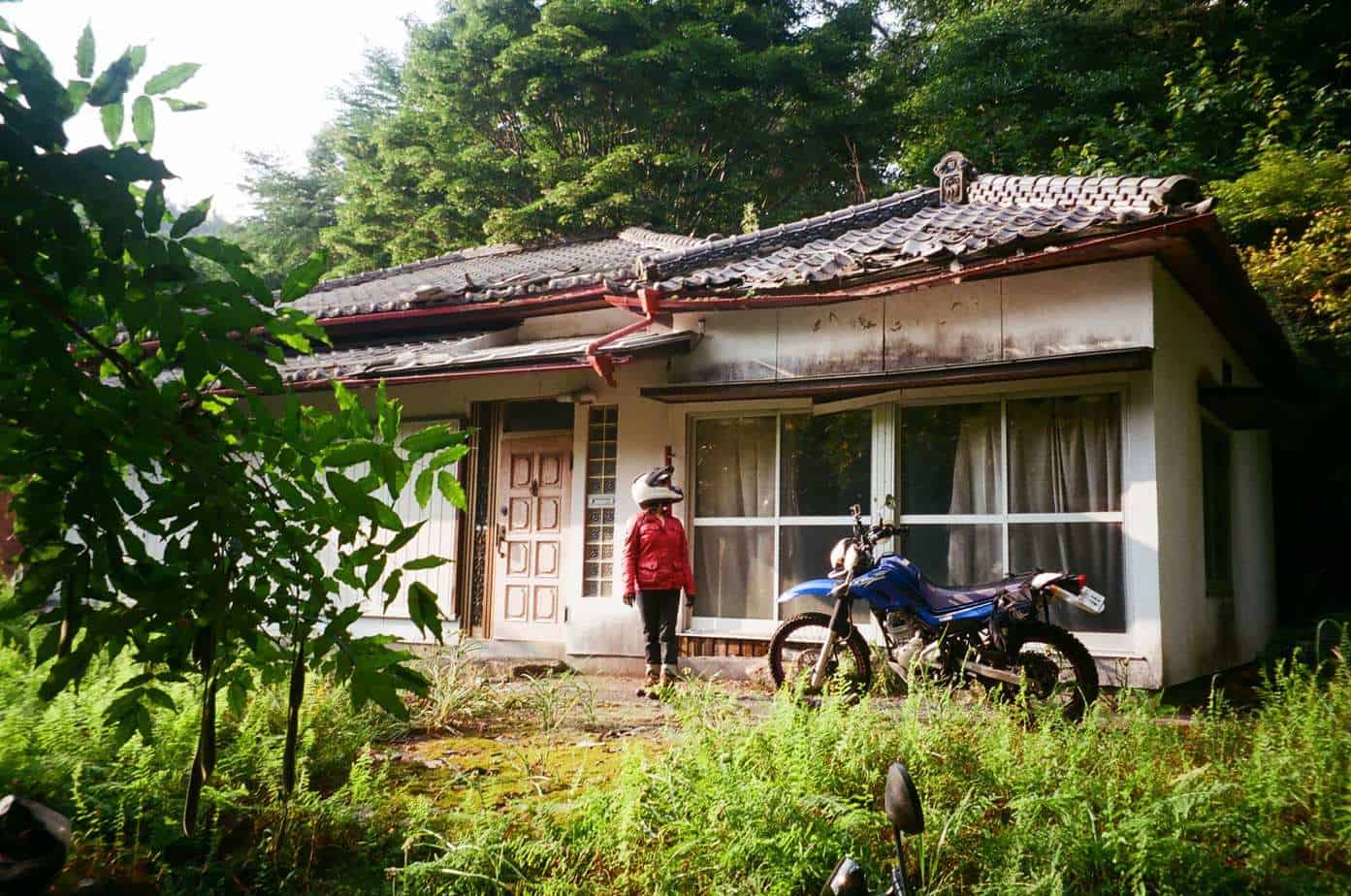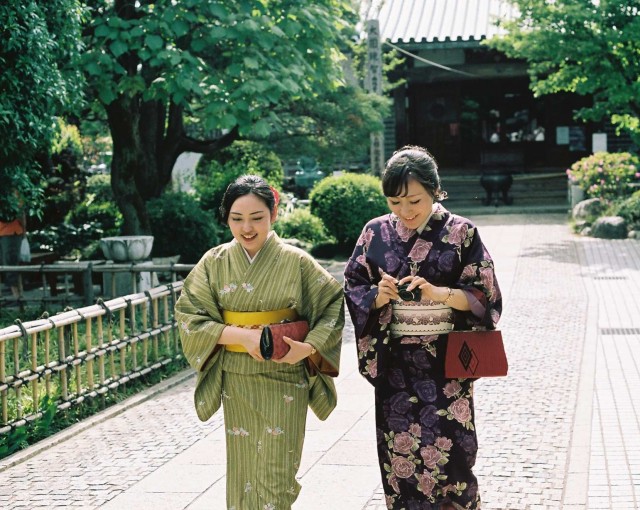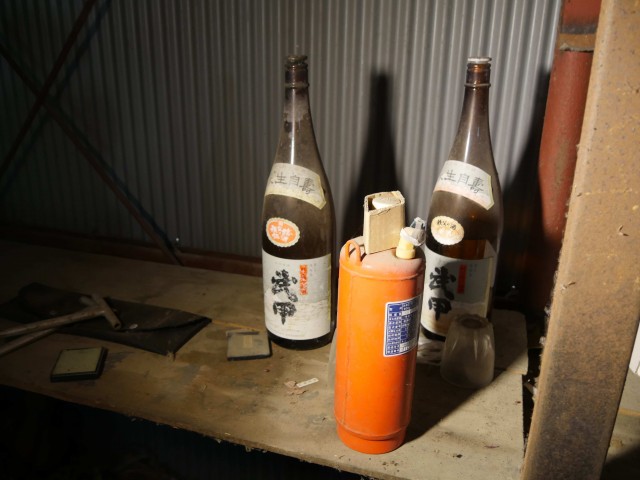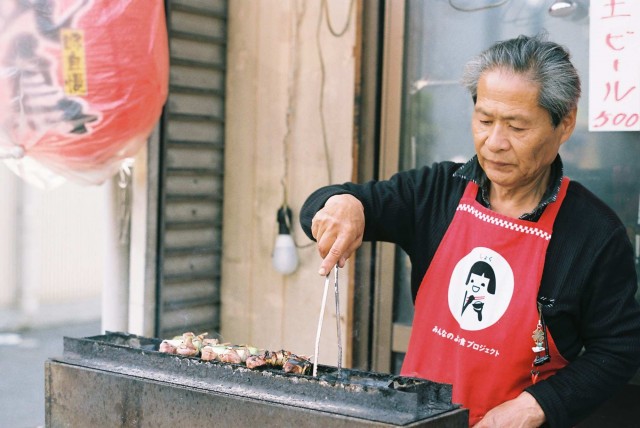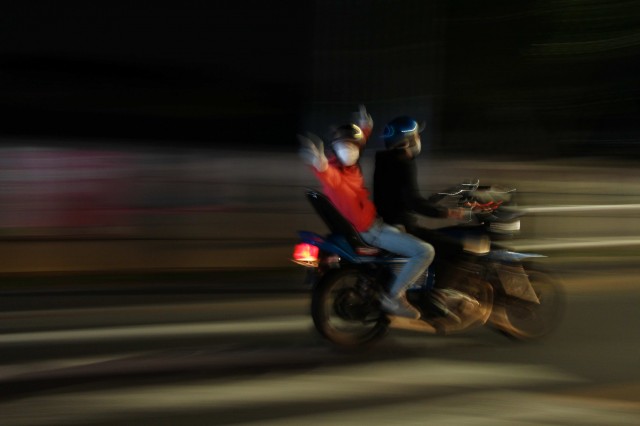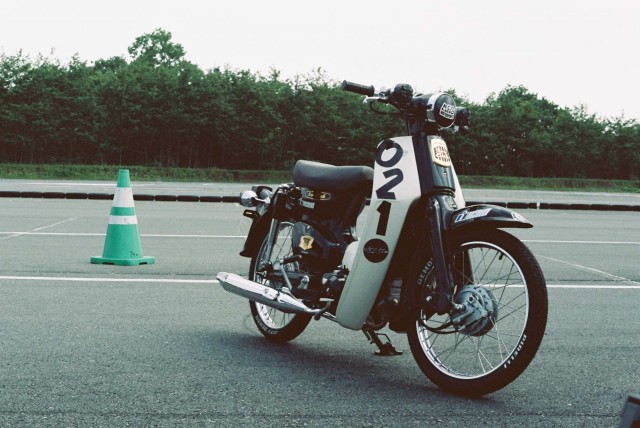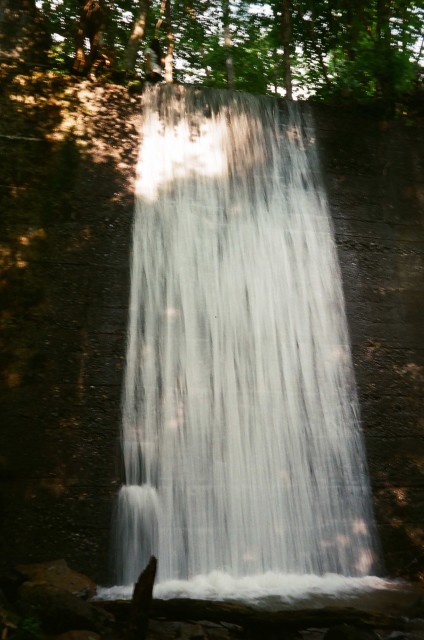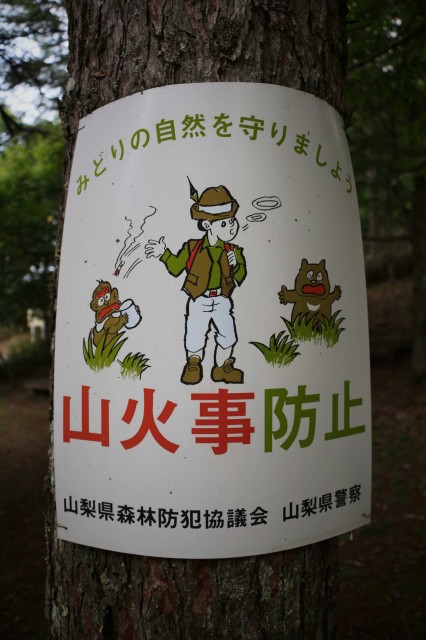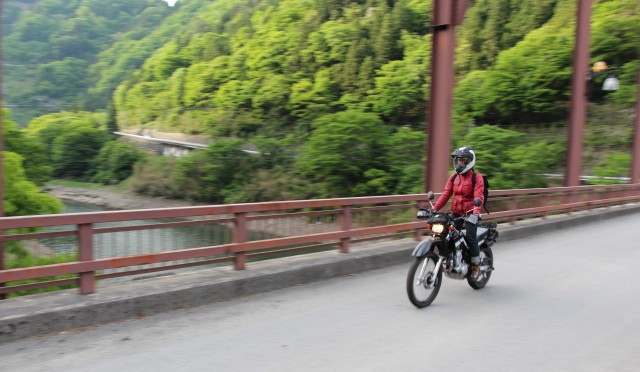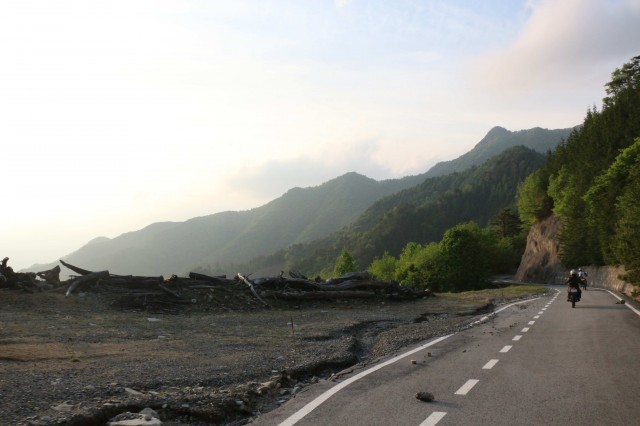“Open it!” I stretched my hand out hesitantly. Who knows what was in that safe… Or what might have wanted out? My breath held as I pulled back the door with as little of my finger tips as possible. There was crap everywhere, so I had to lean away from where I stood. Rust at the hinges stiffened the door. Clearly, it had been opened before, maybe quite recently, but what we found were not the typical treasures of a safe. They were sleeves of 35mm film decayed over decades – some still in decent enough shape to retain an image. To us, this was historical gold – a treasure well worth the hunt. But we couldn’t dwell long. Justin snatched up the only usable sleeve, and we made a mad dash into the empty overgrown path. Chris had noticed some rain drops, and by the time we exited the long forgotten schoolhouse, a monsoon had arrived.
Our equipment, and ourselves, were drenched immediately. We took refuge in a tiny corrugated aluminum shack with an antiquated roll-up door. It was once the town’s fire station erased with the rest of the buildings from any modern maps. Dust and mold engulfed otherwise pristine helmets, uniforms, fire suits and gear. Even medical supplies lay unsullied at our feet. As with the other structures in this mysterious mining village, the men of this establishment seemed to have just picked up what they could fit in their hands and on their backs, then abandoned it with no remorse of the memories left behind. The growl from my stomach cut through my inner monologue. Today was the third of a series of long, sweaty days on the road, camping and searching for these forgotten homesteads. I was tired of riding – glad that in a matter of two more nights, I’d be on a flight bound for the U.S., the first since our arrival in Tokyo three months prior.
“We can’t stay here all day…” I insisted. And with a resounding nod, we ran as fast as we could to the shelter near our motorcycles.
Welcomed Visit to Tokyo
Speeding down an endless Tokyo tunnel, the lights that lined it blurred into a single stroke. A place that defined our time in Japan: fast, mysterious, enchanting, and, seemingly endless. We called it home – mostly because it was unclear when we’d ever see ours again. If things went my way, it would be a long, long time. Late April, it hadn’t hit us yet, but we were about to embark on our first international adventure together. So far, I knew that the trip would take us through the heart of Japan, soon to Italy, then to the Philippines in July. I wouldn’t say there was a set plan. More like guidelines, to keep us moving ever forward, never to be stuck in a single place, for a single reason, with just a single desire. As long as cash flowed, we’d go for it. Surf crystal-blue waves on the Izu Peninsula? Yes. Ride down the coast of Japan? Sign us up. Hunt for Haikyos, the decaying ruins of rural and urban Japan, with a rambunctious gang of expats aboard an assortment of motorbikes? Absolutely!
The first stop in our Tour de Tokyo was an unassuming 7-11. Our insight to the highly refined network of truck stops, rest stops, and convenience stores that exemplified ‘fast food’ perfection. Vending machines are literally everywhere. Little did we know, the products from such institutions would become our staple diet throughout our stint in Japan. But that wasn’t why we were here, nor was it all that important. Our friends had invited us to join them at their new home on a large U.S. Air Force base. “Stay as long as you can!” It was practically a threat to our patriotic loyalties. Who needs America? Japan was calling my name. We were tempted with food, culture and adventure. We heard rumors of a quiet epidemic: citizens fleeing the countryside for bright lights in the inner cities, relinquishing their family homes and villages. There were Haikyos out there, and our friends knew where to find them.
Soon enough I’d be behind the handlebars on a variety of two-wheeled machines winding through the steep peaks adjacent to Mount Fuji – at death defying speeds. Our time was a test of will-power – pushing myself to hike miles uphill in motorcycle gear, counseling myself to ride just a little faster through the windy roads so as not to lose the group. Stimulating my mind with pleasurable thoughts or else I’d never endure the 13-hour seat time. And no, not once would I complain. If life has taught me anything, it’s that whining is a first class ticket to “Uninvited Town.” And I had no plans to visit, ever!
Getting to Know the Neighbors
No more than twenty feet inside the gate, we heard their rhythmic throttles roar past. The tall cement walls of the Yokota Air Base blocked our sight. I could only imagine the colorful show – put on for anyone willing to watch – that has terrorized the soft-spoken, unconditionally cordial Japanese citizens since the 1970s. The Bosozoku: a name synonymous with rebellion and loosely translates to “joy ride,” is a gang, now a lifestyle, still notorious amongst police enforcement. So much so that certain colors and stylings of their flamboyant West Side Story meets Lost Boys uniform are illegal in Japan. And if you’re seen riding your loud, clapped out custom motorcycle at a cruising speed, the cops have permission to stop you… By any means necessary. Don’t run. Your death means nothing to them but speaks volumes to the progress of their safety initiatives.
Harley Lovers were a different matter. You expect a large group of them in a public place to cause trouble, or at the very least irritation. But in Japan, they appear to have an attitude which is carefree, cordial – as the Japanese typically are – and genuinely passionate. It’s funny how being in Japan makes you want a Harley-Davidson. No, seriously. Knuckleheads, Iron-Heads and Pan-Heads galore, with custom weaved steel baskets, water coolers, gas tanks and accents riddle the small streets and expressways. The little things take precedence over the loud things, while the plaid button-up shirts, bandanas, skull caps and lack of any real evidence protective gear recalls the ‘rebel without a cause,’ ‘get the hell out of my way’ attitude that identified the American Kings of Leather and Denim that we’ve come to know so well. “Gangs” of these enthusiasts park in the designated motorcycle spaces, while their captains sit in a circle jovially having conversations, sipping cans of coffee from the vending machine and basking in the sun. It seemed more like a scene from ‘Grease,’ cut during edits due to its provocative nature, ahead of its time, rather than some highly emulated climactic point of 1969’s ode to “Harley Charley’s,” Easy Rider.
These were some of the scenes we came looking for, unbeknownst to us, when we decided to explore the “Land of the Rising Sun.”
The Question Is: Why?
Maybe it shouldn’t be so surprising that the majority of questions we received when telling every one of our plans consisted of why? Why were we going to Japan? To me, it seemed obvious; because we can. It’s beautiful – a little mysterious – and rich with culture, history, loud fashions, delicious food, a dense motorcycle community and windy (Rindo) roads galore. But what really drew us in were the rumors of forgotten structures – from farmhouse to family home, rural villages to mining towns. It was the secrets that beckoned us, the untold stories waiting to be uncovered and exposed. We wanted to leave with nothing but evidence of a substantial past, now deemed irrelevant, burning in our retinas and quivering at the tips of our pencils. Japan offered us an adventure. And we’re not the type to pass on adventures.
Cub-Cup is the Ultimate Challenge
“Gaijin…” (Continued indistinguishable words in Japanese…). The crowd turned to the three of us, the only Americans in a sea of Japanese competitors clad in leathers, and a roar of laughter erupted following a round of applause. We were after all the only “Gaijin” to challenge the locals in one of Japans prized three-hour Honda Cub endurance races, “Kabu Kappu!” (Exclamation point required). It took place on a karting track at the infamous Fuji Speedway, under the namesake’s mountain and a thick low-lying cloud. Chris, our host at the Air Force base, could barely contain himself when he discovered the open-entry motorcycle, er, scooter racing event. And when Justin found the only English translation of the website, we too became increasingly enthusiastic.
Jason is an eccentric character – a sport bike racer turned business man. As a Gaijin, fresh out of the Air Force, he had ended up just outside of Tokyo in a small town called Fussa. He then found himself a wife, made babies, as well as a name for himself and his new business. He’s nearly died, probably more than once. And his business, AFG Motosports, was just a stone’s throw over the tall walls of the military base. He is outgoing and talkative in a way that makes you question his motives, but in the end, he connected us to endless amounts of interesting people – even purchasing a special edition cream-and-black 50cc Honda Super Cub for us to race, then sold it when we brought back the 7th place trophy.
The Sour Side of Sweet
Initially, Japan welcomed us with toothy grins, solemn bows, and gracious manners that never faded. Well, until we accidentally splashed some beer on a middle-aged woman at a Yomiuri Giants baseball game. Our attempts to apologize and offer penance were silenced by a very passive-aggressive, very public, “whoa is me” display. My eyes struggled to make contact with hers to show sincerity, but she was busy avoiding them to continue her diatribe. Maybe it was that experience, or the weeks spent shuffling through the indifferent crowd of subway commuters more interested in the virtual worlds behind their bright blue handheld screens than the life that teemed around them that reminded us, or at least me, of the freedoms, the conversations and the people I’d left behind. I was actually a little home sick.
The permission to shout obscenities in your native tongue on a subway train can be a hell of a good time and all, but standing out in a foreign country can prevent the eager observer from smoothly integrating into the society – if at all. The unrelenting obedience at an empty street – while crowds gathered on the corner with no resistance to the blinking red cross-walk signal – was the slightly disheartening cherry on top, if you will. Everyone there is trained well. So well that the smiles behind the counter seem so genuine, I was ready to report my woes to them like a walk-up therapy clinic – if only I knew Japanese. But the soul behind the facade was one on which we could only speculate. Society perfected their manners, etiquette, shame and subservience in some cases. And finding heart was the treasure posing us a different sort of challenge.
WFO
Dai, a friend and neighboring businessman of Jason’s, was a deep breath of fresh air. He upheld the soft-spoken, kindly nature that we’d found amongst most of the locals, but with far much less of the conformity. He rebelled against all the obedience that was bred into him and did so with respect and, I’d say, some honor. His specialty was to take the biggest baddest of Harley-Davidsons and modifying them to fit the (smaller) stature of the Japanese people. Hey, they love Harleys – or anything Americana for the matter – and the price of cutting those nearly 1,000 pound beasts down to their size seemed well worth it. Like many Japanese craftsman, Dai has an understated skill. He’s a do-it-all mechanic, working with early 20th century machinery; smoking a cigarette and wearing no protection save for some coveralls and work boots poignantly breathing fresh air into lifeless or otherwise forgotten two-wheeled, gas-powered, go-fast gadgets.
If Dai has gotten rich doing it, you couldn’t tell. But he sure loves what he does, and that is genuine. No fake smiles or overdone cordiality. He doesn’t speak a whole lot, but he’ll answer any question he can understand, gladly invite curious onlookers into his humble roadside shop, and then weave through dense traffic on his two-stroke scooter and rev the engine to a monstrous decibel with no apology. Some neighbors look down on him through narrowed eyes and shut their doors in protest. We just laughed and held tight our ears so as not to lose them in all the vibrations. His personal custom project bike hung over the entry: a Harley FXR frame with a CBR600 front end with a little umph in the engine – horsepower well over 100. If there is ever a chance to stop in, oggle the bikes and blow out your eardrums, you can find him (or sometimes not) off of Hwy 16 in Fussa with the doors rolled up, exhaust spilling out, under the sign beaming “WFO…”
Tōge (峠): A Japanese Word Literally Meaning “Pass”
Toge is a term adopted in America as more of a style than a destination. The C shaped stamp left behind from some JDM aftermarket monster going sideways through a hairpin turn is a signature designed on the narrow, windy highways outside of Tokyo. Mountain pass. This was a term we sought out almost as frequently as the Haikyos. Tōge promised fast thrills and cheap tricks. And its unpredictably awnry sister, Rindo, would take us through unpaved paths and trails that strayed from the streets – losing us at the steep summits surrounding Mount Fuji. Some of these Rindo roads were the links which led us to the abandoned homes, businesses and towns we so desperately sought. Expatriates from all over the globe banned together in a foreign land to unveil the secrets and treasures that Japan buried in its forests – modern explorers with more respect than pirates and less obligation than archeologists. Without these expats, we may never have heard of the term “Haikyo.” Without our will, we may never have endured the sweltering humidity and unforeseen treks enough to uncover them.
I had begun to feel a distinct buzz running through my body. Yes, the bike was small and vibrated hard under speed, but we were only going 40 kmph. Maybe it was the heat. I spotted a scrolling sign behind us that said it was 32c (89.6 degrees Fahrenheit) out… Christ. To hell with this ATGATT nonsense! At this rate, I could die of heat stroke before I’d die from an accident. But obedient to my integrity (?), if I had the jacket, I’d wear the jacket. Hot as it was, at least the surroundings were a beautiful distraction. The first Haikyo on our list was an authentic Japanese homestead alone atop a mountain, charred from a recent fire with its sliding doors wide open, wood and linens growing rotten from the seasons, and generation’s worth of artifacts left tidily in place – for the most part. The home itself was a relic sitting on a terraced landscape with a beautiful view, an ancient cemetery, and surrounded by crumbling outbuildings.
Where are they? I wondered. I’m not complaining, but waiting around in my riding gear was stifling. The wind barely broke through the cracks in my coat. But they’ve been gone too long – not long enough for me to be worried, but long enough for me to be antsy. I’d been waiting for this hunt for months. Justin and Chris had wandered off to check the path, to see if we could ride it, or if we’d need to strip down and hike it. They were being way too thorough for my taste. I wanted in. We had made it a third of the way up the mountain with the bikes, thanks entirely to Justin, before we were literally spinning tires in the soft clay Slip ‘n’ Slide that our once narrow rocky path had become. The wheels, caked in mud, didn’t rotate freely any longer. Actually, none of us, the bikes nor ourselves, moved by our own free will. We were at the whims of gravity and ground. It took two of us to balance the lead bike back down the high sided trench as we glided helplessly to a landing. So… we’re going to hike. I stripped my gear, hid them in the bushes and carried on.
Our next destination? A once thriving mining town tucked away between the steep heavily wooded mountainsides that Japan was famous for.
Chichibu Kozen: The Mine; Nichitsu: The Settlement
Wasps flew freely in and out of sight. In Japan, the wasps are no joke. Their sizes range from coin to palm – or so I’m told. What I do know is that their sting can be fatal and their temperament is fickle. That was enough information to make us cautious. Slowly, we reached through the long opened window, careful to avoid rusty nails, shards of glass and angry spiders. The withered magazine read “1972” on its cover, and the lack of further evidence around the lifeless apartment confirmed our suspicions: this village had been deserted as early as the 70’s. For miles we saw isles of apartments, outhouses and commercial buildings quietly collapsing from the weight of time and neglect.
We gingerly crossed a single-chain gate at the entrance of the central part of town. A small bevy of deer leapt away from a cluster of rundown buildings into the woods at the sound of us. Where to start? Structures of various ages, styles and sizes remained well intact as the village’s timeline – birth dates ranging from the turn of the century to the death of disco. The herd had brought our attention to one of the more modern structures, its exterior hidden by a hedge gone wild. We pushed through the branches into the only doorway we could find, and entered a series of rooms – to include a kitchen, pantry, guest rooms and what could have been a bathroom – which insinuated that this was once a place of business – an office, maybe? A “Dragonball Z” calendar from the early 90s told us when it was last inhabited. Poking around one of the spare rooms, I searched for proof of life in the closet to no avail.
“Guys… Turn around slowly, and walk out of the room until I tell you to stop.” Uh… Chris sounded tense. “I’ll tell you in a minute, just keep walking.” He was cryptic for a reason – any sudden movements could have unleashed a deadly fury from the wasps’ nest tucked into the closet that I had just unknowingly revealed. It was below the shelf, and I was too close to it to notice. A massive solitary wasp led Chris’ eyes to the hive. Like coming up late on a messy scene in a movie, the three of us backed up slowly, turned when it was clear and speed-walked stiffly out of the office building. Sphincters relaxed when we made it back to the main road. Our laughter was more nervous than humored, but the (very) close encounter with a surefire fatality wasn’t enough to deter us from the exploration. And, so, we carried on.
At the far end of town, atop an embankment which loomed over a dry river bed, stood a narrow wooden building. With both of its doors missing, the building boasted nothing significant on its rotten sinking floors other than a chalkboard and a standup piano. Looking around, there wasn’t much else to suggest what the wide open room once was, save for some shelving at its perimeter, scattered papers, and a few ragged toys. A school was the conclusion. We weren’t the first to visit since its closure – fresh chalkboard graffiti covered the fading Konji. Skirting the edges around the soft spots, we wandered to the back and found ourselves in a tiny dark room, shit strewn everywhere. We tip toed around the junk when something ‘special’ caught our eyes… It was a safe.


